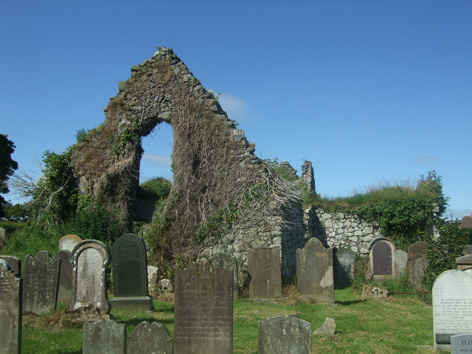
Templecorran Graveyard
The graveyard of Templecorran stands on an Early Christian ecclesiastical site. Though none of the buildings of this monastery survive, there is an Early Christian cross-inscribed stone in the graveyard. What may be the original boundary ditch that surrounded this site, a massive circular enclosure, can still be traced in surrounding fields. With a diameter of 320 metres, it is one of the largest enclosures to surround an ecclesiastical site in Ireland.
The monastery closed, possibly due to Viking attacks, but through the medieval period the site was the location of a parish church, possibly the ‘Church of Laslaynan’ as recorded in the papal taxation of 1306.
The arrival of the Scots
In the early seventeenth century the Ballycarry area was a favoured destination for Scottish settlers landing in east Antrim. In 1613 the Rev. Edward Brice was appointed as the first Presbyterian minister of Templecorran. Brice had previously been minister of Drymen in Stirlingshire but had fallen into disfavour with the authorities in Scotland.
In early seventeenth-century Ulster, some tolerance was shown towards ministers with Presbyterian sympathies, so Brice ministered to the Scots of the Broadisland settlement. He was deposed by the religious authorities for his Presbyterianism in 1636, shortly before he died.
The church ruins
The roofless ruins of the church in which Brice once preached stand reasonably intact, though very little architectural detail is now visible.
The design of this church is important because it is one of a number of churches known to have been built by the Scots in early seventeenth-century Ulster on the plan of a Greek cross, that is, with each arm of the cross of equal length.
What is unclear is whether the church we see today was built in its entirety in the early seventeenth century or whether it was a rebuilding of an earlier rectangular- plan structure to which aisles were added. Cruciform churches were virtually unknown in medieval Ulster and certainly there were no churches, so far as is known, on the plan of a Greek cross.
Another reason that this ruin is of great interest is the twelve musket loops in its walls. It appears the church was more than just a place of worship – it was also designed to provide refuge in case of attack.
Later history of the church
It seems that this church was in use for less than 50 years. In 1657, a Cromwellian investigation noted that the church was in repair. The minister at this time was Rev. Robert Cunningham, a Presbyterian. He was deposed in 1661 for refusing to accept the Episcopal form of church government, but remained in the area to minister to the Presbyterian population.
Templecorran church fell into a state of disrepair and in 1679 it was described as being in ruins. For a brief period in the 1690s, it was one of the parishes for which the celebrated novelist, Jonathan Swift, was responsible. Swift later described his sermons during this period as ‘calculated for a church without company or a roof’. He may well have been thinking about Templecorran when he wrote this!
In1847 a new Anglican church dedicated to St John was built in Templecorran, on a site adjoining the old churchyard.
The churchyard
For a country churchyard, this burial ground has an astonishing array of memorials of interest, dating back over a thousand years. The Ordnance Survey Memoir of the parish of Templecorran of 1840 makes this comment about the churchyard:
The burial ground includes a quadrangular area 176 feet square, enclosed by a double fence and a treble row of young trees…….It is quite occupied with graves and to judge from their number and proximity must, from a very remote period, have been a general place of interment for the people of the surrounding country.
Since then the graveyard has been extended on a number of occasions – 1884, 1900, 1905 and 1913.
The oldest memorial in the churchyard is a stone featuring an incised cross within a circle which almost certainly dates from the Early Christian period. It is thought to have come from an old church site at Redhall.
Other interesting features:
Mausoleum, James Orr’s Grave, Close up of Ballycarry martyr’s grave, Masonic Symbols on Orr Tombstone

